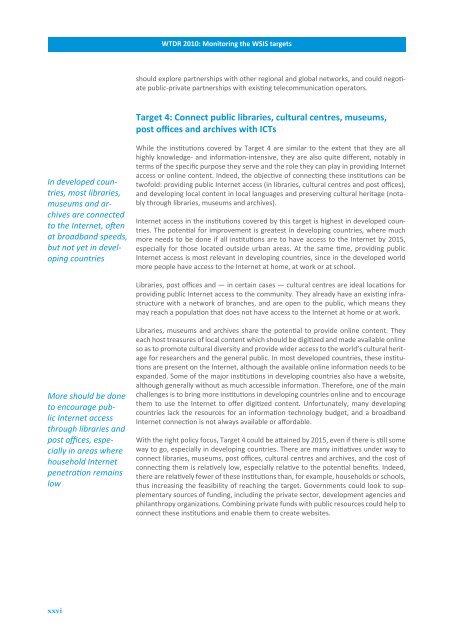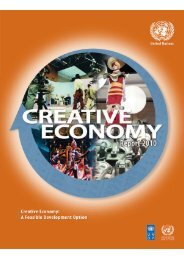Monitoring the WSIS targets
Monitoring the WSIS targets
Monitoring the WSIS targets
- No tags were found...
You also want an ePaper? Increase the reach of your titles
YUMPU automatically turns print PDFs into web optimized ePapers that Google loves.
WTDR 2010: <strong>Monitoring</strong> <strong>the</strong> <strong>WSIS</strong> <strong>targets</strong>should explore partnerships with o<strong>the</strong>r regional and global networks, and could negotiatepublic-private partnerships with existing telecommunication operators.Target 4: Connect public libraries, cultural centres, museums,post offices and archives with ICTsIn developed countries,most libraries,museums and archivesare connectedto <strong>the</strong> Internet, oftenat broadband speeds,but not yet in developingcountriesWhile <strong>the</strong> institutions covered by Target 4 are similar to <strong>the</strong> extent that <strong>the</strong>y are allhighly knowledge- and information-intensive, <strong>the</strong>y are also quite different, notably interms of <strong>the</strong> specific purpose <strong>the</strong>y serve and <strong>the</strong> role <strong>the</strong>y can play in providing Internetaccess or online content. Indeed, <strong>the</strong> objective of connecting <strong>the</strong>se institutions can betwofold: providing public Internet access (in libraries, cultural centres and post offices),and developing local content in local languages and preserving cultural heritage (notablythrough libraries, museums and archives).Internet access in <strong>the</strong> institutions covered by this target is highest in developed countries.The potential for improvement is greatest in developing countries, where muchmore needs to be done if all institutions are to have access to <strong>the</strong> Internet by 2015,especially for those located outside urban areas. At <strong>the</strong> same time, providing publicInternet access is most relevant in developing countries, since in <strong>the</strong> developed worldmore people have access to <strong>the</strong> Internet at home, at work or at school.Libraries, post offices and — in certain cases — cultural centres are ideal locations forproviding public Internet access to <strong>the</strong> community. They already have an existing infrastructurewith a network of branches, and are open to <strong>the</strong> public, which means <strong>the</strong>ymay reach a population that does not have access to <strong>the</strong> Internet at home or at work.More should be doneto encourage publicInternet accessthrough libraries andpost offices, especiallyin areas wherehousehold Internetpenetration remainslowLibraries, museums and archives share <strong>the</strong> potential to provide online content. Theyeach host treasures of local content which should be digitized and made available onlineso as to promote cultural diversity and provide wider access to <strong>the</strong> world’s cultural heritagefor researchers and <strong>the</strong> general public. In most developed countries, <strong>the</strong>se institutionsare present on <strong>the</strong> Internet, although <strong>the</strong> available online information needs to beexpanded. Some of <strong>the</strong> major institutions in developing countries also have a website,although generally without as much accessible information. Therefore, one of <strong>the</strong> mainchallenges is to bring more institutions in developing countries online and to encourage<strong>the</strong>m to use <strong>the</strong> Internet to offer digitized content. Unfortunately, many developingcountries lack <strong>the</strong> resources for an information technology budget, and a broadbandInternet connection is not always available or affordable.With <strong>the</strong> right policy focus, Target 4 could be attained by 2015, even if <strong>the</strong>re is still someway to go, especially in developing countries. There are many initiatives under way toconnect libraries, museums, post offices, cultural centres and archives, and <strong>the</strong> cost ofconnecting <strong>the</strong>m is relatively low, especially relative to <strong>the</strong> potential benefits. Indeed,<strong>the</strong>re are relatively fewer of <strong>the</strong>se institutions than, for example, households or schools,thus increasing <strong>the</strong> feasibility of reaching <strong>the</strong> target. Governments could look to supplementarysources of funding, including <strong>the</strong> private sector, development agencies andphilanthropy organizations. Combining private funds with public resources could help toconnect <strong>the</strong>se institutions and enable <strong>the</strong>m to create websites.xxvi
















